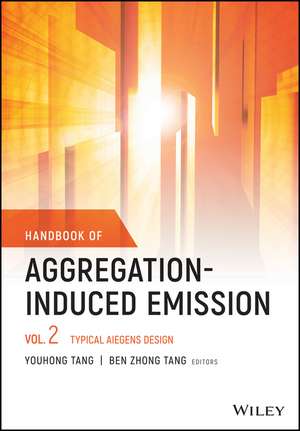Handbook of Aggregation–Induced Emission: Vol 2 Ty pical AIEgens Design
Autor Y Tangen Limba Engleză Hardback – 27 apr 2022
The second volume of the ultimate reference on the science and applications of aggregation-induced emission
The Handbook of Aggregation-Induced Emission explores foundational and advanced topics in aggregation-induced emission, as well as cutting-edge developments in the field, celebrating twenty years of progress and achievement in this important and interdisciplinary field. The three volumes combine to offer readers a comprehensive and insightful interpretation accessible to both new and experienced researchers working on aggregation-induced emission.
In Volume 2: Typical AIEgens Design, the editors address the design and synthesis of typical AIEgens that have made significant contributions to aggregation-induced emission research. Recent advances in the development of aggregation-induced emission systems are discussed and the book covers novel aggregation-induced emission systems in small molecule organogels, polymersomes, metal-organic coordination complexes and metal nanoclusters. Readers will also discover:
- A thorough introduction to the synthesis and applications of tetraphenylpyrazine-based AIEgens, AIEgens based on 9,10-distyrylanthracene , and the Salicylaldehyde Schiff base
- Practical discussions of aggregation-induced emission from the sixth main group and fluorescence detection of dynamic aggregation processes using AIEgens
- Coverage of cyclic triimidazole derivatives and the synthesis of multi-phenyl-substituted pyrrole based materials and their applications
Perfect for academic researchers working on aggregation-induced emission, this set of volumes is also ideal for professionals and students in the fields of photophysics, photochemistry, materials science, optoelectronic materials, synthetic organic chemistry, macromolecular chemistry, polymer science, and biological sciences.
Preț: 1143.83 lei
Preț vechi: 1663.61 lei
-31% Nou
218.87€ • 228.52$ • 181.14£
Carte indisponibilă temporar
Specificații
ISBN-10: 1119642981
Pagini: 624
Dimensiuni: 178 x 263 x 36 mm
Greutate: 1.44 kg
Editura: Wiley
Locul publicării:Chichester, United Kingdom
